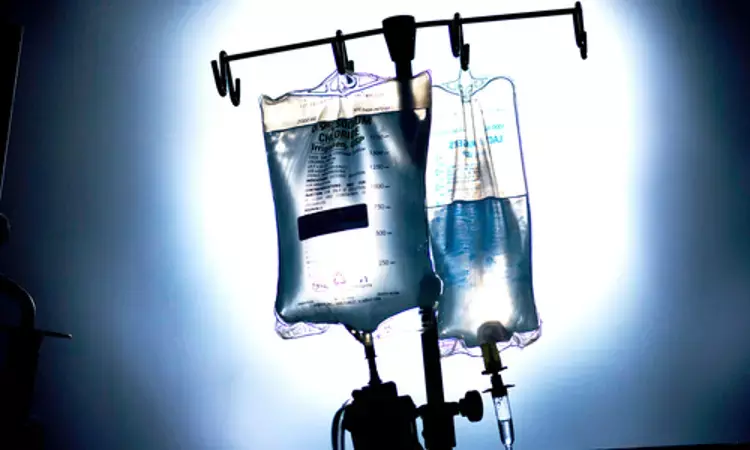- Home
- Medical news & Guidelines
- Anesthesiology
- Cardiology and CTVS
- Critical Care
- Dentistry
- Dermatology
- Diabetes and Endocrinology
- ENT
- Gastroenterology
- Medicine
- Nephrology
- Neurology
- Obstretics-Gynaecology
- Oncology
- Ophthalmology
- Orthopaedics
- Pediatrics-Neonatology
- Psychiatry
- Pulmonology
- Radiology
- Surgery
- Urology
- Laboratory Medicine
- Diet
- Nursing
- Paramedical
- Physiotherapy
- Health news
- Fact Check
- Bone Health Fact Check
- Brain Health Fact Check
- Cancer Related Fact Check
- Child Care Fact Check
- Dental and oral health fact check
- Diabetes and metabolic health fact check
- Diet and Nutrition Fact Check
- Eye and ENT Care Fact Check
- Fitness fact check
- Gut health fact check
- Heart health fact check
- Kidney health fact check
- Medical education fact check
- Men's health fact check
- Respiratory fact check
- Skin and hair care fact check
- Vaccine and Immunization fact check
- Women's health fact check
- AYUSH
- State News
- Andaman and Nicobar Islands
- Andhra Pradesh
- Arunachal Pradesh
- Assam
- Bihar
- Chandigarh
- Chattisgarh
- Dadra and Nagar Haveli
- Daman and Diu
- Delhi
- Goa
- Gujarat
- Haryana
- Himachal Pradesh
- Jammu & Kashmir
- Jharkhand
- Karnataka
- Kerala
- Ladakh
- Lakshadweep
- Madhya Pradesh
- Maharashtra
- Manipur
- Meghalaya
- Mizoram
- Nagaland
- Odisha
- Puducherry
- Punjab
- Rajasthan
- Sikkim
- Tamil Nadu
- Telangana
- Tripura
- Uttar Pradesh
- Uttrakhand
- West Bengal
- Medical Education
- Industry
Lactated Ringer's Superior to Normal Saline in Treating Sickle Cell Vaso-occlusive episodes: Study

Grandmother Holds Drip for Injured Grandson in Govt Hospital
Researchers found that lactated Ringer (LR) solution may indeed surpass normal saline (NS) in helping the sickle cell disease (SCD) patient in painful vaso-occlusive episodes (VOEs). Hydration is an indispensable element against hypovolemia, and what has shown from preclinical evidence is that NS may promote erythrocyte sickling, worsening the patients' condition. Recently, a multicenter cohort study compared the efficacy of LR and NS for fluid resuscitation in hospitalized SCD patients. The study was published recently in JAMA Internal Medicine by Augusta and colleagues.
This study aimed to compare, in adults admitted to the hospital for VOEs, the effectiveness of LR versus NS fluid resuscitation in patients with SCD. This was a multicenter cohort study. It was designed as a target trial emulation using data from the Premier PINC AI database over 2016-2022, which covers an approximate 25% sample of U.S. hospitalizations. This is a retrospective analysis of adults who were inpatients with sickle cell disease, had VOEs, and were treated with either LR or NS on hospital day 1. Patient encounters were entered between October 6, 2023 and June 20, 2024. There were 55,574 total patient encounters. Of those, 3,495 patients were treated with LR, and 52,079 patients received NS. The median age of the patients was 30 years, with an IQR of 25-37 years.
Patients with SCD who had VOEs were divided into two groups: LR (intervention) for fluid resuscitation on hospital day 1, and patients NS (control) for fluid resuscitation on day 1. A primary outcome was the number of HFDs at day 30. Secondary outcomes were also length of stay and 30-day readmission risk. TMLE was used to estimate marginal effect values. The paper also analyzed how treatment effects vary with the volume of fluids infused in patients.
Results
• Patients who received LR spent more hospital-free days than did those who received NS, with a marginal mean difference of 0.4 days (95% CI, 0.1-0.6 days).
• LR was associated with shorter hospital stay, with a marginal mean reduction of 0.4 days (95% CI, −0.7 to −0.1 days).
• The patients who were assigned to LR had fewer chances of readmission in 30 days with a marginal risk difference of 5.8% (95% CI, −9.8% to −1.8%).
• On patients who received more than or equal to 2 liters of fluid, LR was significantly better as compared with NS. On patients who received less than 2L, there was no difference regarding risk compared with the two fluids.
It is suggested that lactated Ringer solution should be used for fluid resuscitation instead of normal saline in a patient with SCD at the time of experiencing a vaso-occlusive episode. Hospital free days, hospital days, and the probability of readmission were significantly better in patients who received LR. These findings show the use of LR to be more effective in improving clinical outcomes and thus be included in the therapy regimens.
Reference:
Alwang, A. K., Law, A. C., Klings, E. S., Cohen, R. T., & Bosch, N. A. (2024). Lactated Ringer vs normal saline solution during sickle cell Vaso-occlusive episodes. JAMA Internal Medicine. https://doi.org/10.1001/jamainternmed.2024.4428
Dr Riya Dave has completed dentistry from Gujarat University in 2022. She is a dentist and accomplished medical and scientific writer known for her commitment to bridging the gap between clinical expertise and accessible healthcare information. She has been actively involved in writing blogs related to health and wellness.
Dr Kamal Kant Kohli-MBBS, DTCD- a chest specialist with more than 30 years of practice and a flair for writing clinical articles, Dr Kamal Kant Kohli joined Medical Dialogues as a Chief Editor of Medical News. Besides writing articles, as an editor, he proofreads and verifies all the medical content published on Medical Dialogues including those coming from journals, studies,medical conferences,guidelines etc. Email: drkohli@medicaldialogues.in. Contact no. 011-43720751


